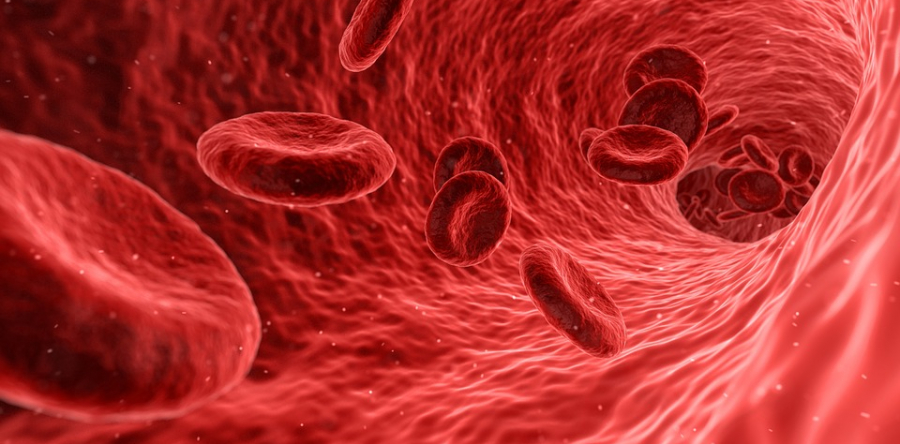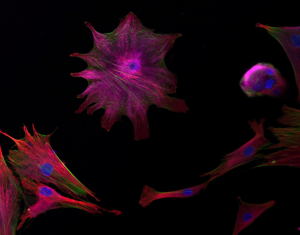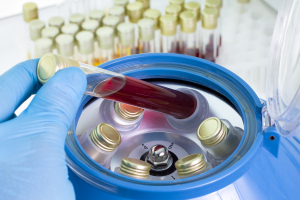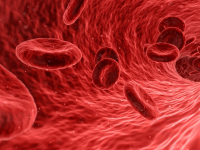
Lately I have had patients asking me about stem cell injections for arthritis, newly popular treatment for a variety of aliments. Stem cells are immature cells that have not yet "differentiated" or formed into their final cell type. This makes them very useful in regenerative medicine and also controversial.
Stem cells can be found in many tissues through out the body including bone marrow, fat, muscle, and brain tissue. 1 Stem cells can also be harvested from human embryos. This particular topic is very controversial and not on our agenda for today. So lets just stick to what we call "adult" stem cells, or those harvested from grown humans. The beauty of an undifferentiated stem cell is in its future. Much like a young college co-ed, it doesn't know what exactly it will be when it grows up, but the world is often its oyster.

Kelly Hotchkiss, student, VCU Department of Biomedical Engineering, School of Engineering Hotchkiss’ image shows human mesenchymal stem cells that present a spread pattern of attachment after being prepared on a glass surface." 2
Depending on what tissue the stem cell is harvested from will determine what cell lines it could potentially form. For example, in orthopedics we love to use the bone marrow because it contains a stem cell known as the mesenchymal cell (MSC).1 This cell line has the potential to turn into bone and cartilage.1 Other cell lines in bone marrow have potential to turn into other blood cells, etc. This is useful in certain cancer treatments when patients are in need of more healthy cells/blood. Also, once implanted it is thought that the cell is actually influenced by the cells around it to differentiate into the same type of tissue.1 A kind of scientific peer pressure if you will!
Mesenchymal cells can be harvested from different areas of the body. The characteristics of the cells may vary slightly depending on the harvest site, but the important factor is if the MSC can turn into a "chondrocyte" or cartilage cell. For this reason many surgeons like to use bone marrow, intuitively one would think that MSC from bone would have a high potential to turn into bone and cartilage tissues. Also these cell lines are the most studied forms, with experiments dating back to the 1960s. More recently fat has been used as a donation site for stem cells. Adipose (fat) tissue also contains mesenchymal cells and as one article put it, "adipose is an abundant and easily accessible source." 3 So essentially we have A LOT more fat to choose from as a society, why not use it!
Bone marrow is usually harvested from the hip in the operating room under anesthesia. Adipose tissue can be taken from several areas including the stomach, love handles, and buttocks. Once harves
ted it is treated to remove excess cells and spun down using a machine called a centrifuge to get MSCs. The cells are then re-implanted into the knee (for example) in the area of the cartilage defect. Post operative protocols are varied depending on surgeon but may include non-weight baring for a period of time, braces, and physical therapy.

These procedures are still new and considered experimental by insurance companies. This makes them cost more money out of pocket unfortunately. Where there is exciting research being done on the topic the results vary from paper to paper and I would consider the jury still out on some of the overall conclusions. Before undergoing these injections make sure you have a conversation with your provider and understand exactly what to expect.
Sources:
1. http://stemcells.nih.gov/info/basics/Pages/Default.aspx
2. https://news.vcu.edu/article/Small_wonders_The_microscopic_images_currently_on_display_at
3. Koh, Y. G., MD, Kwon, O. R., MD, & Kim, Y. S., MD. (2014). Second look arthroscopic evaluation of cartilage lesions after mesenchymal stem cell implantation in osteoarthritic knees. The American Journal of Sports Medicine, 42(7), 1628-1637. Retrieved April 12, 2016, from www.sagepub.com/journalsPermissions.nav.


